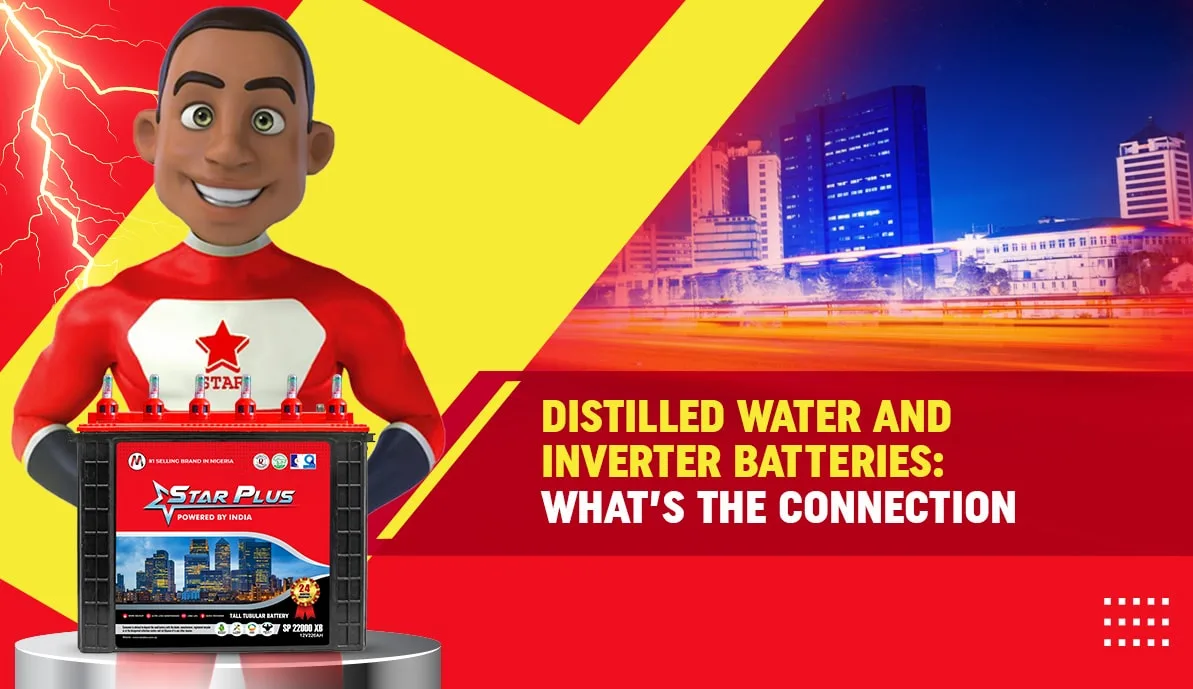Congratulations on purchasing an inverter battery! High-powered inverter batteries have revolutionised the power backup system in Nigeria. However, just purchasing an inverter battery is not enough; maintaining it is also essential. It is equally necessary to learn about the maintenance tips that will increase the longevity of your battery.
One of the most crucial factors is to top up Distilled Water in inverter batteries. But how exactly can one source and use this?
In this blog, we’ll discuss the post-purchase necessities of an inverter battery. Continue reading to learn more about the connection between distilled water usage and inverter batteries so that you can receive an uninterrupted power supply.
What is Distilled Water?
Distilled water is water in its purest form and is devoid of ions. This property enables distilled water to be used in many applications, including replenishing inverter batteries, car batteries, and medical appliances.
Role of Water in Battery Function
Water is a key component of the electrolyte solution in the inverter batteries. It facilitates specific chemical reactions that produce electricity. This also helps to maintain the acid-water balance inside the inverter so that the chemical reactions can take place properly.
The presence of impurities and minerals can disrupt these chemical reactions, leading to decreased battery performance and increased wear.
Comparison of Using Tap Water, Mineral Water, and Distilled Water
Inverter battery users often have this misconception of using tap water and mineral water for their batteries. However, both tap water and mineral water contain ions, which can disrupt chemical reactions within the batteries. As a result, high risks of your inverter battery getting damaged can arise. Distilled water remains the only ideal battery water to date and is only used for topping up.
Check out the steps for filling distilled water in an inverter battery.
Guide on How to Fill Distilled Water in an Inverter Battery
1. Check Safety First
Before you proceed to fill distilled water in your inverter battery, check your safety first. Adhere to the stringent safety measures provided or conveyed by your inverter battery manufacturer.
Turn off your inverter and disconnect it from the power source. To prevent any mishaps, equip yourself with safety gear, safety glasses, and gloves.
2. Choose the Right Water
Choosing the right water is of the utmost importance. You can source battery-distilled water from any inverter battery supplier or supply unit. As an authentic inverter battery manufacturer, we can guide you regarding sourcing distilled water and how to top up the water.
3. Check Water Levels
Open the battery vent caps and perform a thorough inspection of the water levels. Ensure that the water level falls above the minimum mark, but stays below the maximum mark. This particular check is crucial for the proper functioning of the inverter battery.
Want to Buy Tubular Inverter Battery for Your Home and Office?
4. Top-Up with Water
If the water level of your battery lies below the minimum mark, you might need a funnel to top up the water. Take your time to prevent overfilling. Otherwise, the hustle might compromise a battery’s performance.
5. Wait for Absorption
After adding distilled water to your inverter battery, you need to provide the electrolyte with sufficient time to absorb the water. Analysing this waiting period will help you to detect how often you need to fill distilled water in inverter battery.
6. Recheck and Seal
Following the absorption phase, you need to recheck and reevaluate the water levels in your inverter battery. Once you can detect a satisfactory water level, seat the battery vent caps to prevent evaporation.
7. Check for Excess Spillage
Do not clean spilled water with a vacuum cleaner, but only with a clean cloth. Wiping off excess water around the battery is essential to prevent corrosion. This would ultimately preserve the battery’s lifespan and reduce replacement risks.
When to Add Distilled Water to an Inverter Battery
Our inverter batteries have a water level indicator that confirms the existing water levels. You need to check for the indicator to replenish the water inside the batteries. Apart from the in-built battery indicator, you can keep a reminder on your mobile or elsewhere. Note down the previous intervals of topping up water in a battery and set a reminder based on similar intervals.
Conclusion
Maintaining water levels is necessary for managing an inverter battery’s functional ability. At Star Plus Battery, we will ensure that you receive proper guidance in sourcing and topping up distilled water in your battery. Consistent monitoring and timely water top-ups are key practices that will enhance the efficiency of your inverter batteries.
Take care of the ones who light up your homes.



0 Comments